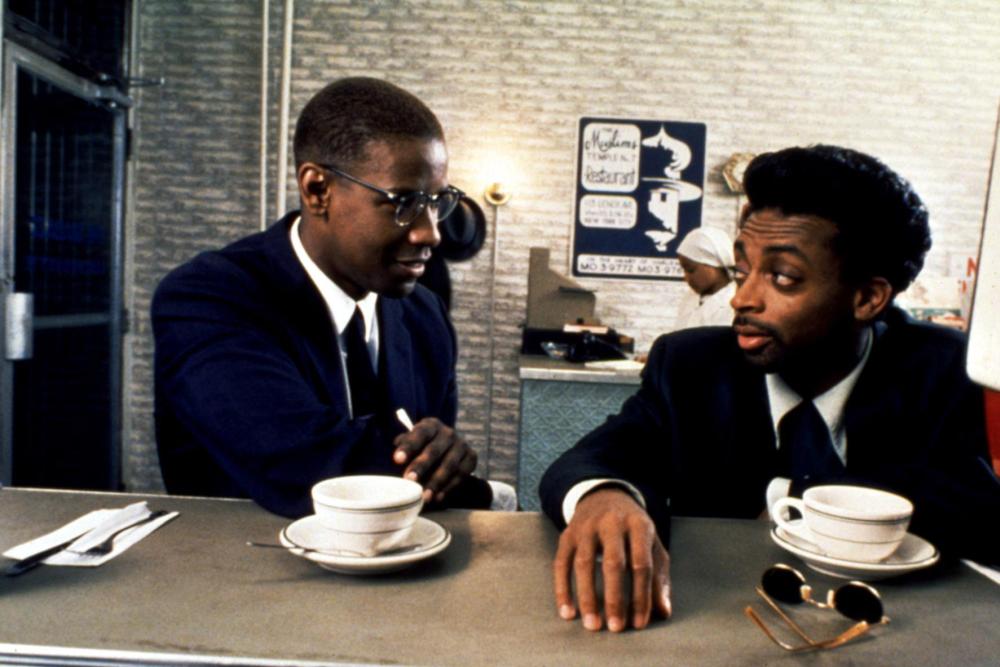Malcolm X
Dir. Spike Lee
1992
I was thrilled when Madison film critic, programmer and friend Jason Furhman held a screening of Spike Lee’s Malcolm X as part of his Madison Library Cinesthesia screening series earlier this year. It’s a film I’ve adored since I first saw it in June of 2016, with Spike Lee having grown to be one of my all-time favorite filmmakers, but I especially appreciated watching it while so much conversation centered on last year’s biggest surprise hit, Christopher Nolan’s Oppenheimer. To be able to compare and contrast these epic length biographical films, whose stories as central American political figures were swallowed up for decades by slander and misrepresentation, was to me a unique and thoughtful programming choice. If we can convince Jason to start putting his program notes online, I’ll update this piece to include a link to them – he very comprehensively laid out the history of this film’s production and reception, and I’d feel foolish trying to sum up his work here.
Spike Lee’s Malcolm X is the ultimate example of my “cathedral” model for masterpieces. The film takes you past grand images of seemingly isolated frescoes and gives you the space to really linger in them, either relishing in the details or taking in the grand effect. I found myself focusing on the big picture on this watch – there is absolutely an effect to watching so many consecutive scenes of Malcolm’s ascent from street preacher to national preacher, so many consecutive scenes of Baines converting him, so many consecutive scenes of the violence his family was threatened with. It creates the sense of his total devotion to the cause. If the audience struggles to sit with it for an hour, imagine the conviction it took to live it for twelve years.
Contrast this with the propulsive structure of Nolan’s Oppenheimer. Nolan manages three separate timelines throughout the film, cross-cutting across decades to synthesize meaning, creating one linear thematic jist out of three nonlinear ellisions. The emotional weight of that film is reaching across time, allowing our feelings about Oppenheimer’s trial to reach back to our feelings about the Trinity Test itself. Here, Lee instead uses a cumulative emotional weight, guiding us through the story as it happened, giving the audience the responsibility to link repeated themes into syllogism. You may not have the full symbolic meaning of Delroy Lindo’s false idol of charismatic organized crime when we first see Malcolm jailed, but the image sticks in the brain long enough to start seeing parallels with Al Freeman Jr.’s Elijah Muhammad.
I find myself surprised at the resistance some film fans have had to embracing Spike Lee as one of the great American filmmakers. Do The Right Thing has fully arrived, for sure, but I feel the rest of his work is often still seen as homework, uneven, unfamiliar deep cuts. It’s maybe never been more obvious than the gap between critics and general esteem for Da 5 Bloods, once again starring Lindo, a film too few saw. Malcolm X is one of those films that breaks through partly because Denzel Washington, the greatest living movie star, gives his most beloved and iconic performance in the title role. He gets to be everything – a cult of personality, a sex symbol, the kindest man you’ve ever seen, a messiah sending himself to absolution, an angry spirit of vengeance, a funny firebrand, a wilting flower. To say everything there is to say about Washington would reward a scene-by-scene breakdown of exactly what he’s doing and the way he strings incredible continuity over the entire film.
I chose this film for the birthday project on April 24th, one week into Columbia University students camping in protest of Columbia University’s ties to the genocidal Israeli government and the ongoing annihilation of Gaza and Palestine. I find myself starting this piece on May 3rd, after a week of disproportionate police abuse of those protesters, Zionist counter-protestors at UCLA assaulting the Free Palestine encampment with fireworks and bricks, and our own UW-Madison calling MPD on the student body. I did not, at the time, foresee the renewed conversation about “peaceful protest” and police violence reaching the height that it has. Any study of Malcolm X will once again reveal that even peaceful protest will be slandered as violence, that malfeasance can be manufactured, that “progressive” is not a linear stamp where the powers that be let difference in opinion live.
